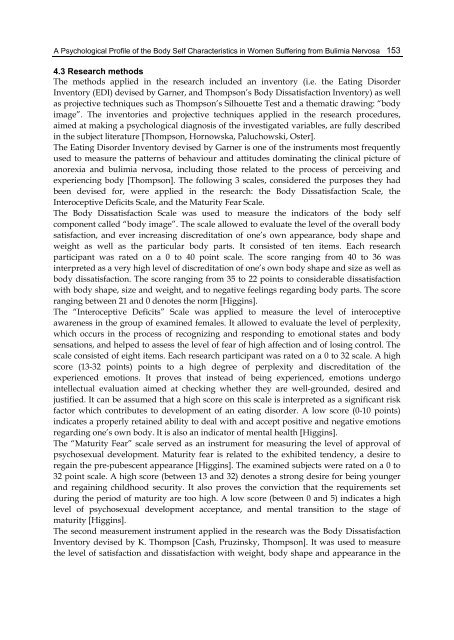new insights into the prevention and treatment of bulimia nervosa
new insights into the prevention and treatment of bulimia nervosa
new insights into the prevention and treatment of bulimia nervosa
Create successful ePaper yourself
Turn your PDF publications into a flip-book with our unique Google optimized e-Paper software.
A Psychological Pr<strong>of</strong>ile <strong>of</strong> <strong>the</strong> Body Self Characteristics in Women Suffering from Bulimia Nervosa<br />
4.3 Research methods<br />
The methods applied in <strong>the</strong> research included an inventory (i.e. <strong>the</strong> Eating Disorder<br />
Inventory (EDI) devised by Garner, <strong>and</strong> Thompson’s Body Dissatisfaction Inventory) as well<br />
as projective techniques such as Thompson’s Silhouette Test <strong>and</strong> a <strong>the</strong>matic drawing: “body<br />
image”. The inventories <strong>and</strong> projective techniques applied in <strong>the</strong> research procedures,<br />
aimed at making a psychological diagnosis <strong>of</strong> <strong>the</strong> investigated variables, are fully described<br />
in <strong>the</strong> subject literature [Thompson, Hornowska, Paluchowski, Oster].<br />
The Eating Disorder Inventory devised by Garner is one <strong>of</strong> <strong>the</strong> instruments most frequently<br />
used to measure <strong>the</strong> patterns <strong>of</strong> behaviour <strong>and</strong> attitudes dominating <strong>the</strong> clinical picture <strong>of</strong><br />
anorexia <strong>and</strong> <strong>bulimia</strong> <strong>nervosa</strong>, including those related to <strong>the</strong> process <strong>of</strong> perceiving <strong>and</strong><br />
experiencing body [Thompson]. The following 3 scales, considered <strong>the</strong> purposes <strong>the</strong>y had<br />
been devised for, were applied in <strong>the</strong> research: <strong>the</strong> Body Dissatisfaction Scale, <strong>the</strong><br />
Interoceptive Deficits Scale, <strong>and</strong> <strong>the</strong> Maturity Fear Scale.<br />
The Body Dissatisfaction Scale was used to measure <strong>the</strong> indicators <strong>of</strong> <strong>the</strong> body self<br />
component called “body image”. The scale allowed to evaluate <strong>the</strong> level <strong>of</strong> <strong>the</strong> overall body<br />
satisfaction, <strong>and</strong> ever increasing discreditation <strong>of</strong> one’s own appearance, body shape <strong>and</strong><br />
weight as well as <strong>the</strong> particular body parts. It consisted <strong>of</strong> ten items. Each research<br />
participant was rated on a 0 to 40 point scale. The score ranging from 40 to 36 was<br />
interpreted as a very high level <strong>of</strong> discreditation <strong>of</strong> one’s own body shape <strong>and</strong> size as well as<br />
body dissatisfaction. The score ranging from 35 to 22 points to considerable dissatisfaction<br />
with body shape, size <strong>and</strong> weight, <strong>and</strong> to negative feelings regarding body parts. The score<br />
ranging between 21 <strong>and</strong> 0 denotes <strong>the</strong> norm [Higgins].<br />
The “Interoceptive Deficits” Scale was applied to measure <strong>the</strong> level <strong>of</strong> interoceptive<br />
awareness in <strong>the</strong> group <strong>of</strong> examined females. It allowed to evaluate <strong>the</strong> level <strong>of</strong> perplexity,<br />
which occurs in <strong>the</strong> process <strong>of</strong> recognizing <strong>and</strong> responding to emotional states <strong>and</strong> body<br />
sensations, <strong>and</strong> helped to assess <strong>the</strong> level <strong>of</strong> fear <strong>of</strong> high affection <strong>and</strong> <strong>of</strong> losing control. The<br />
scale consisted <strong>of</strong> eight items. Each research participant was rated on a 0 to 32 scale. A high<br />
score (13-32 points) points to a high degree <strong>of</strong> perplexity <strong>and</strong> discreditation <strong>of</strong> <strong>the</strong><br />
experienced emotions. It proves that instead <strong>of</strong> being experienced, emotions undergo<br />
intellectual evaluation aimed at checking whe<strong>the</strong>r <strong>the</strong>y are well-grounded, desired <strong>and</strong><br />
justified. It can be assumed that a high score on this scale is interpreted as a significant risk<br />
factor which contributes to development <strong>of</strong> an eating disorder. A low score (0-10 points)<br />
indicates a properly retained ability to deal with <strong>and</strong> accept positive <strong>and</strong> negative emotions<br />
regarding one’s own body. It is also an indicator <strong>of</strong> mental health [Higgins].<br />
The “Maturity Fear” scale served as an instrument for measuring <strong>the</strong> level <strong>of</strong> approval <strong>of</strong><br />
psychosexual development. Maturity fear is related to <strong>the</strong> exhibited tendency, a desire to<br />
regain <strong>the</strong> pre-pubescent appearance [Higgins]. The examined subjects were rated on a 0 to<br />
32 point scale. A high score (between 13 <strong>and</strong> 32) denotes a strong desire for being younger<br />
<strong>and</strong> regaining childhood security. It also proves <strong>the</strong> conviction that <strong>the</strong> requirements set<br />
during <strong>the</strong> period <strong>of</strong> maturity are too high. A low score (between 0 <strong>and</strong> 5) indicates a high<br />
level <strong>of</strong> psychosexual development acceptance, <strong>and</strong> mental transition to <strong>the</strong> stage <strong>of</strong><br />
maturity [Higgins].<br />
The second measurement instrument applied in <strong>the</strong> research was <strong>the</strong> Body Dissatisfaction<br />
Inventory devised by K. Thompson [Cash, Pruzinsky, Thompson]. It was used to measure<br />
<strong>the</strong> level <strong>of</strong> satisfaction <strong>and</strong> dissatisfaction with weight, body shape <strong>and</strong> appearance in <strong>the</strong><br />
153














![focuspdca.ppt [Compatibility Mode]](https://img.yumpu.com/22859457/1/190x146/focuspdcappt-compatibility-mode.jpg?quality=85)


